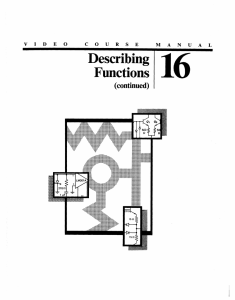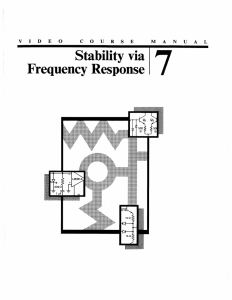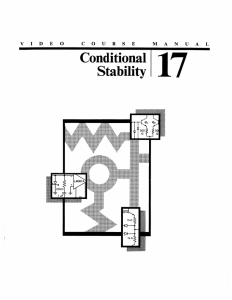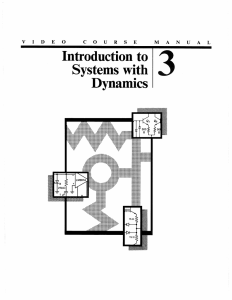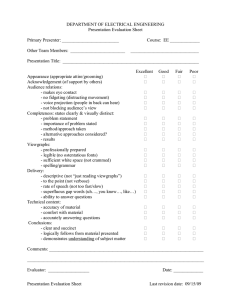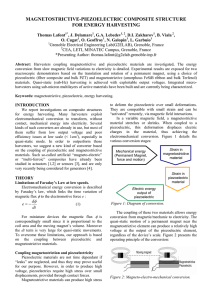DESIGN PROBLEM #3 Lecture 20 16.20 Handed Out:
advertisement
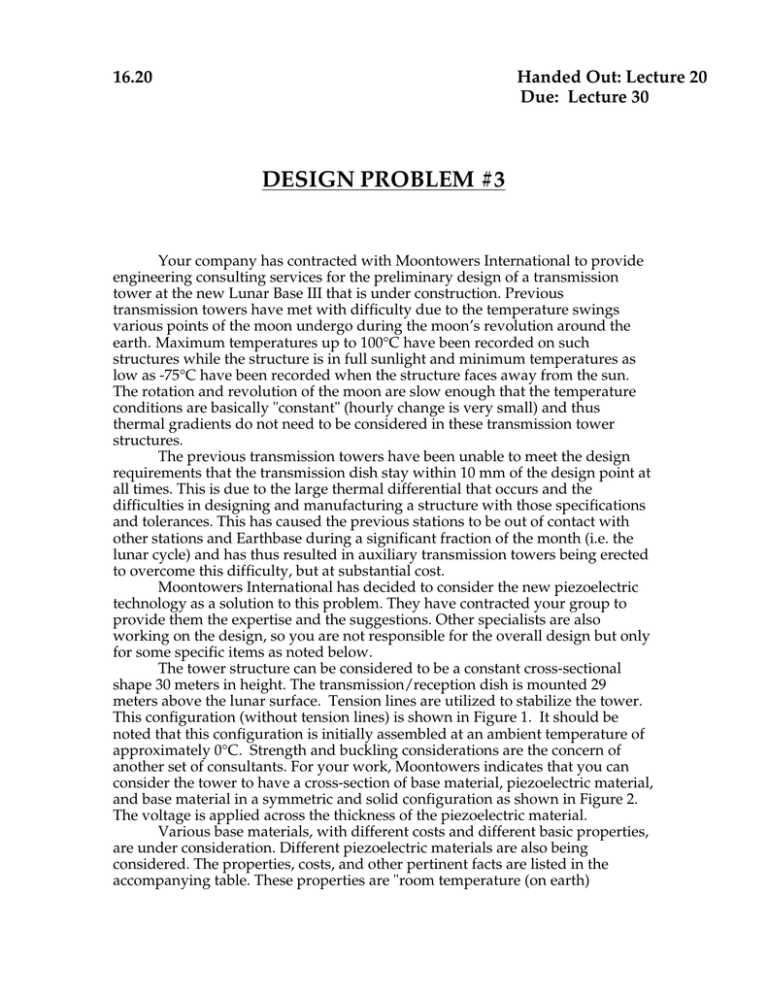
Handed Out: Lecture 20 Due: Lecture 30 16.20 DESIGN PROBLEM #3 Your company has contracted with Moontowers International to provide engineering consulting services for the preliminary design of a transmission tower at the new Lunar Base III that is under construction. Previous transmission towers have met with difficulty due to the temperature swings various points of the moon undergo during the moon’s revolution around the earth. Maximum temperatures up to 100°C have been recorded on such structures while the structure is in full sunlight and minimum temperatures as low as -75°C have been recorded when the structure faces away from the sun. The rotation and revolution of the moon are slow enough that the temperature conditions are basically "constant" (hourly change is very small) and thus thermal gradients do not need to be considered in these transmission tower structures. The previous transmission towers have been unable to meet the design requirements that the transmission dish stay within 10 mm of the design point at all times. This is due to the large thermal differential that occurs and the difficulties in designing and manufacturing a structure with those specifications and tolerances. This has caused the previous stations to be out of contact with other stations and Earthbase during a significant fraction of the month (i.e. the lunar cycle) and has thus resulted in auxiliary transmission towers being erected to overcome this difficulty, but at substantial cost. Moontowers International has decided to consider the new piezoelectric technology as a solution to this problem. They have contracted your group to provide them the expertise and the suggestions. Other specialists are also working on the design, so you are not responsible for the overall design but only for some specific items as noted below. The tower structure can be considered to be a constant cross-sectional shape 30 meters in height. The transmission/reception dish is mounted 29 meters above the lunar surface. Tension lines are utilized to stabilize the tower. This configuration (without tension lines) is shown in Figure 1. It should be noted that this configuration is initially assembled at an ambient temperature of approximately 0°C. Strength and buckling considerations are the concern of another set of consultants. For your work, Moontowers indicates that you can consider the tower to have a cross-section of base material, piezoelectric material, and base material in a symmetric and solid configuration as shown in Figure 2. The voltage is applied across the thickness of the piezoelectric material. Various base materials, with different costs and different basic properties, are under consideration. Different piezoelectric materials are also being considered. The properties, costs, and other pertinent facts are listed in the accompanying table. These properties are "room temperature (on earth) 16.20 Design Problem #3 Fall, 2002 Page 2 properties". Consultation with Moontowers personnel indicates that it is sufficient to ignore variation of these properties with temperature in the preliminary design work. Since other factors may come into play in choosing the base material, you need to come up with a design for each base material and the advantages and disadvantages associated with each case. The "design" includes three key points: the relative thickness of the base material to the piezoelectric material (other considerations will set the actual thickness), a formula which can be used as a baseline for setting the needed applied voltage to achieve the desired condition given a measured temperature, and the maximum voltage required. The current feeling is that a controller will check the temperature of the structure on an hourly basis and will be able to manually change the voltage input to the piezoelectric material. (This will later be automated after the initial concept and configuration is shown to function properly.) In addition to the design for each case, you should arrive at a recommendation for the best configuration overall given the factors you have been asked to consider. Tradeoffs, pros and cons associated with this and this decision are important. Moontowers will, of course, make the final decision based on the input of the various consultants. Thoughts about Piezoelectricity, electrical supply, etc. The piezoelectric materials under consideration are ceramics which are basically isotropic within the plane of importance. The 3-direction is to be oriented in the thickness direction and the 1-direction is to be oriented along the length of the tower. The plane of isotropy is the 1-2 plane. These piezoelectric materials have limits as to the electric field that can be applied before they depole. This limits their real usability to the linear range of about half their depoling field as indicated in the accompanying table. Increased need for voltage for a particular configuration means that there will be additional cost to "stationkeep". The design of the infrastructure (electrical supply and demands) of the Lunar Base III is still undergoing change, so final details are not available. Voltage will be supplied via solar panels, so it can only be said that more voltage will require more cost.....possibly including installation of more solar panels. Unfortunately, more specific information is not available at the current time. How and What... A brainstorming session of the representatives of each of the engineering consulting firms will be held to go over the results and suggestions of each group and to fuse these and tradeoff to arrive at a final design. You will need to prepare a viewgraph presentation of your work and results. A ten-minute presentation is planned (you do not need to give the presentation as part of this actual exercise), but each firm should prepare viewgraphs in preparation for this. 16.20 Design Problem #3 Fall, 2002 Page 3 A good groundrule is one viewgraph for each minute of presentation. In addition, a covering letter to the president of the company, Mr. Lou N. Arlander, should be prepared to transmit the viewgraphs and an engineering appendix containing all the pertinent calculations and other needed information. Clearly, the members of the consulting team should be indicated in this letter as well as the chair of the team. Information on preparing viewgraphs can be obtained from people in the MIT Writing/Communications Program, colleagues in 16.62X, thoughts from Unified, and other sources. Here are some basic rules/suggestions: • Don't make the information content on one viewgraph too dense. Limit each viewgraph to one major point with clarifying subpoints. • Don't go into all the details, just hit the highlights. • Don't use full sentences. Get rid of unnecessary articles, modifiers, etc. Transmit the highlight(s) of the idea/information. • It is important to review how you approached the problem, but it is more important to give the background information and to thoroughly outline your results and suggestions -- tell the story you are trying to transmit. • Try to avoid equations, describe them instead. If equations are absolutely necessary to get your point across, limit them to two on a viewgraph (one is even better). • Use figures wherever appropriate. Avoid tables, as the message can generally be better transmitted through some type of figure. • Good rules of thumb (according to Lagace, anyhow) with regard to the mechanics of a viewgraph: – Title of viewgraph (main point) in 36-point font – Subpoints in 24-point font – No font smaller than 18-point anywhere (you should be able to read the viewgraph if you put it on the floor and you are standing erect) – Five bullets (subpoints) are plenty, six is stretching it – You can put a "wrap-up" point in italics in 24-point font at the bottom Sample viewgraphs can be viewed upon request. A possible progression of viewgraphs might be: The Problem, Advantages of Piezoelectric Materials, Approach/Concept, Design Tradeoffs, Possible Configurations, Results, Other Considerations, Recommendations. 16.20 Design Problem #3 Fall, 2002 Page 4 Figure 1 Overview of tower structure Figure 2 Cross-section configuration of tower 1 3 piezoelectric tb tp tb 29 m 30 m base material V base material 16.20 Design Problem #3 Fall, 2002 Page 5 TABLE 1 Base Material Properties Aluminum (7075-T6) Titanium (Ti-6Al-4V) Graphite/Epoxy Layup A (AS4/3501-6) High Modulus Graphite/Epoxy Layup B (P70/3501-6) EL [GPa] 70 107 80 170 ET [GPa] 70 107 30 25 ν αL [µstrain/°F] 0.30 0.30 0.43 0.45 12.9 5.0 4.2 2.1 αT [µstrain/°F] 12.9 5.0 7.3 6.3 ρ [g/cm3 ] 2.80 4.43 1.54 1.60 60 85 140 300 Manufacturing cost [$/lb] TABLE 2 Piezoelectric Material Properties PZT 4 PZT 5H PZT 5A 64 48 53 4.5 4.5 4.5 0.31 0.31 0.31 d113 [µstrain/V/mm] -0.123 -0.274 -0.171 d333 [µstrain/V/mm] 0.289 0.593 0.374 10 4 7 ρ [g/cm3 ] 7.50 7.50 7.50 Manufacturing cost [$/lb] 5600 5600 5600 E [GPa] α [µstrain/°C] ν Depoling Voltage [kV/cm]


